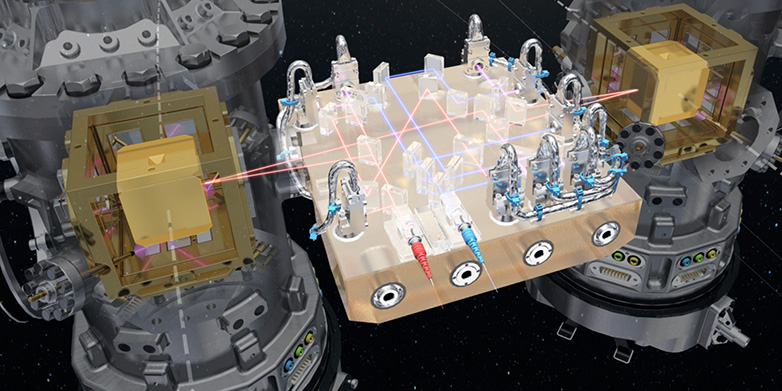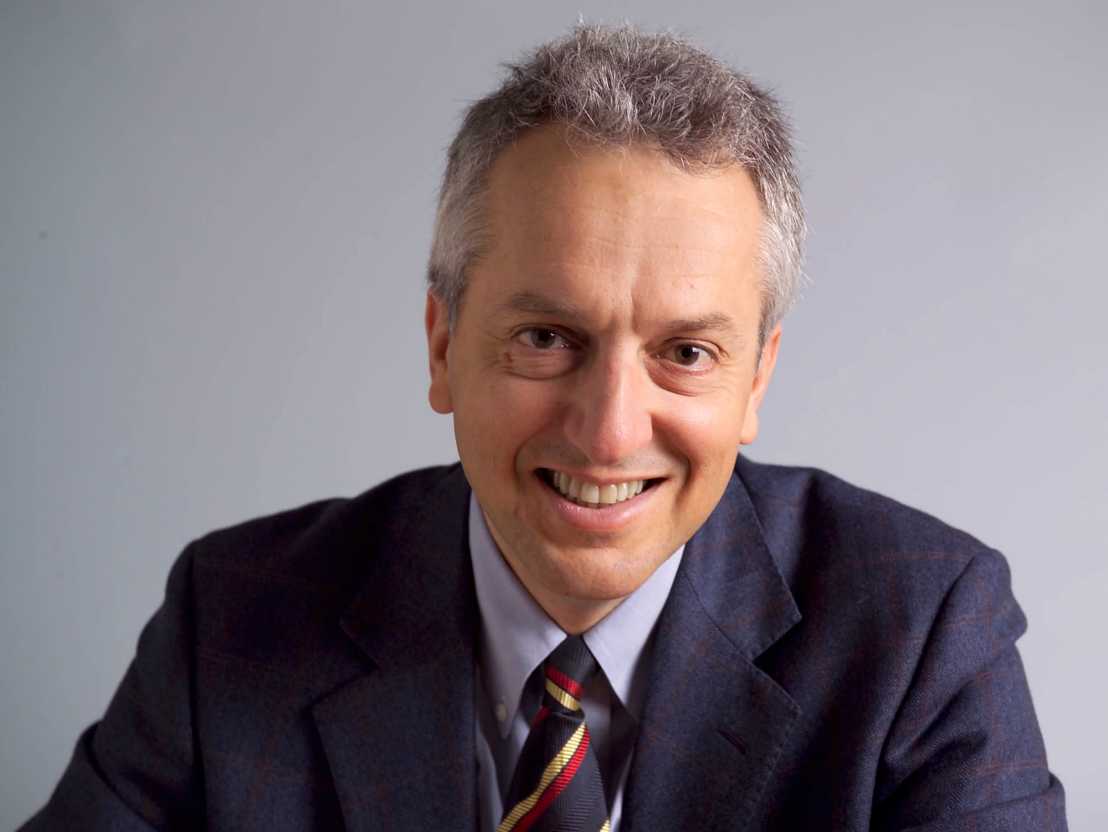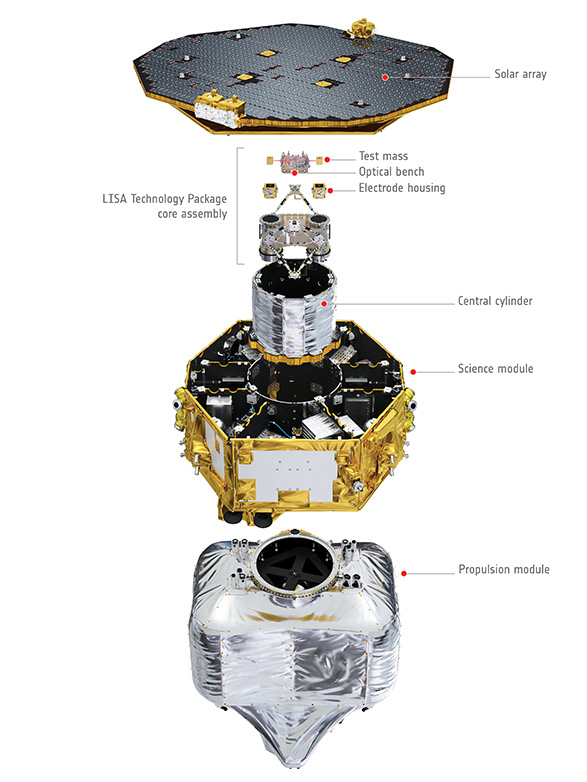Precise to the nearest picometre
The European Space Agency (ESA) presented results from its LISA Pathfinder mission in Madrid. The measuring instruments and control electronics, developed for LISA Pathfinder by ETH Zurich Professor Domenico Giardini and his team, are even more precise than expected. The technology is ready for use on the LISA gravitational wave observatory.

Back in December, ESA launched the LISA Pathfinder satellite from its spaceport in Kourou, French Guiana. For a period of 12 months, LISA Pathfinder tested measuring technologies that scientists hoped to use to prove the existence of gravitational waves. According to Einstein’s General Theory of Relativity, when extremely large energy episodes occur in the universe, such as the collision of two black holes, gravitational waves should be emitted.
After just two months, ESA announced in Madrid on June 7th 2016 that the measuring technology has proven successful in experiments and tests. In the latest issue of the science journal Physical Review Letters, the LISA Pathfinder consortium reveals that the two test masses on board the satellite show hardly any deviations in their relative positions: the relative acceleration is an unimaginably tiny fraction (10-15) of the acceleration due to gravity (g=9,8 m/sec2). Most notably, the advanced measuring system is capable of determining the slightest deviation in the positions of the dice with an accuracy of one picometre, which is equal to one trillionth of a metre, significantly outperforming requirements.
ETH Zurich Professor, Domenico Giardini developed the measuring instruments and control electronics for LISA Pathfinder that are currently keeping the satellite on a steady course. In an interview with ETH News, the seismologist explains the meaning of the results, and how gravitational waves in space will be researched in future.

Are you pleased with the results of the LISA Pathfinder mission?
Yes, very pleased. The measuring and control system we designed here at ETH Zurich is extremely precise. The two mass cubes move by only one picometre relative to each other – that’s just 0.000000000001 metres. In other words, the movement is incredibly small! A helium atom, the smallest of all atoms, measures around 32 picometres in diameter. It’s impossible to verify such tiny shifts in position on earth with normal instruments, so we had to develop all the devices from the ground up and test them in space.
Why is there a need for such extreme precision?
The technologies tested by Pathfinder are going to be used on an even bigger mission. LISA (Laser Interferometer Space Antenna) is an ESA space observatory planned for the measurement of gravitational waves. As part of that mission, ESA wants to send three satellites into space in the year 2034, organising them in a triangular formation millions of kilometres away from earth. Each satellite will carry two test masses on board; laser beams will connect the masses between the satellites. On the LISA Pathfinder, the distance between the masses was just 48 centimetres; on LISA it’ll be at least 1.5 million kilometres, maybe even 5 million kilometres. So precision becomes even more important in order to measure deviations between the two masses.
Physicists working on the external pageLIGOcall_made experiment proved the existence of gravitational waves for the first time last autumn. Did this have any negative repercussions for LISA?
No, not at all. LIGO’s proof of gravitational waves was positive for LISA. In fact, things seem to be moving forward much faster now.
Why is that?
The episode LIGO verified was very short lasting just 0.1 seconds and produced by the merging of two black holes. Each of them had a mass that was 30 times greater than the sun, and they were 1.3 billion light years away from us. So ESA is even more convinced of LISA’s necessity, because we now know that gravitational waves exist, and that we can detect the largest energy episodes. Before this, we had to convince investors, other scientists, and industrial partners that Einstein was actually right, and that this research was necessary to prove his theories. It's clear that such research is costly, but thanks to the LIGO findings, the basis for LISA is more solid than ever.

But doesn't LIGO make the LISA mission superfluous to some extent?
No. LIGO will continue to look for gravitational waves, and further develop their infrastructure. However, a facility like this can only hope to detect a small number of episodes per year, since the ‘noise’ on earth is so high. Also, the size of LIGO’s facilities means that it can only measure wavelengths of a few kilometres. The measuring system planned in space as part of LISA, on the other hand, will be millions of kilometres long. We’ll therefore be able to capture totally different frequencies of gravitational waves as well as tens of thousands of energy episodes each year. So the ‘noise’ we’ll be encountering won’t be from the kind found on earth, but rather the signals emanating from the largest episodes in the universe!
Can the technology from LISA Pathfinder be carried over to LISA’s vast dimensions?
The principle of the experiment is the same. The majority of the apparatus, such as the test mass, their containers, and the sensors that measure the location of the mass, can be scaled. Nevertheless, we’ll still have to increase the precision by ten-fold. The laser system will be different on LISA too; it will need stronger lasers that can cross the enormous distances from one satellite to another.
Will you also be involved in LISA?
Both my team and Professor Philippe Jetzer's team at the University of Zurich will continue to be involved. The work of our teams will complement each other. We will work on the measuring and control electronics, while Philippe’s team carries out the astrophysical groundwork. The first meeting with ESA has already taken place. At the moment we’re working on preparing the specifications for the mission. We hope to launch LISA in a few years.
Going back to LISA Pathfinder, what happens with the satellites now?
ESA will carry out experiments on the platform for a further three months. The purpose of these will be to better understand effects that have an influence on precision. After that, the satellite will fly gradually towards the sun, so we won’t witness its last moments.
Why is a seismologist involved in a space mission for gravitational waves?
The core of the experiment is the ability to measure very precisely the position of a mass inside the instrument, and this is also the principle of the seismometer! Gravitational waves are waves, and seismologists are good at measuring waves!
When you look back on this project, does it strike you as one of the most important and difficult ones you’ve undertaken in your career?
In terms of the duration and technical difficulty of the project, the answer is, "Yes." The idea of measuring gravitational waves in space was born 40 years ago. Back then, it failed on technical grounds, but eventually ESA decided to conduct a test mission – LISA Pathfinder. That assignment alone has already involved 15 years of my life, LISA might well take up another 15. This is a life-long project. It's not very often that you get the chance to work on a project that lasts 30 years, so it’s a great honour for me to be part of it!
About Domenico Giardini
Domenico Giardini is Full Professor of Seismology and Geodynamics at the ETH Zürich, Switzerland, since 1997. He is a Co-Principal Investigator of the 2015 ESA Pathfinder mission, to test technologies for the detection of gravitational waves, and of the 2016 NASA InSight mission, to install a seismometer on Mars.
